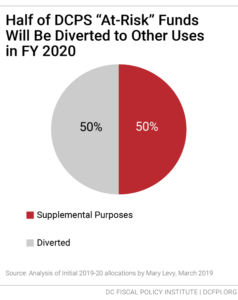Every student in DC deserves to attend an adequately funded public school. Yet the District’s mechanism for funding public schools, the Uniform Per Student Funding Formula (UPSFF), is failing to keep up with the rising costs of education and is $900 below the amount recommended in the 2013 DC Education Adequacy Study. This inadequacy leads DC Public Schools (DCPS) to routinely misspend supplemental funds that are intended to improve academic achievement among students at-risk of falling behind.
The Deputy Mayor of Education (DME) recently commissioned a new study that will examine ways to strengthen the adequacy of the formula and at-risk supplement. To ensure the findings are both evidence-based and community-informed, researchers leading the study should engage parents and other community stakeholders throughout the process.
In particular, the study will review the following:
- The adequacy of the current design of the at-risk funding supplement and whether the UPSFF should provide additional funding to schools with high concentrations of at-risk students;
- What it actually costs to provide basic educational services to every DC public school student and what drives these costs; and,
- Whether and how the current English Learner weight in the funding formula should be tiered (rather than flat) to reflect differing costs by service needs, which can vary by student characteristics.
The UPSFF is the primary tool for allocating funds to DCPS and public charter schools. The UPSFF starts with a foundational level dollar amount (or “base funds”) that is meant to reflect the per-student amount needed to provide general education services, with adjustments for students in different grade levels. The formula also provides additional funding to schools for serving students in special education, English Learners, and students who are considered “at-risk.” At-risk funds promote equity by helping low-income students and other students facing challenges (such as those experiencing homelessness) access the same enriching opportunities as their higher-income peers and ensuring that students who may be struggling academically get the targeted supports — such as academic coaches or tutoring programs — they need to succeed in the classroom.
By law, DCPS is required by to use at-risk funds to supplement (i.e., add to), not supplant (i.e., replace), funds in schools’ budgets. However, DCPS knowingly diverts half of this funding for other purposes, such as art teachers and librarians — positions schools are already supposed to receive to under the staffing model. Tracking the use of at-risk funds in public charter schools is more challenging. Because there are no standard staffing requirements in public charter schools or requirements for at-risk spending plans — unlike in DCPS schools — it is not easy to decipher how the charter system is using at-risk funds to supplement services.
DCPS robs students of a fair shot at academic success when it supplants at-risk funds. Some principals are forced to cut staff or services due to reduced budgets, disrupting schools’ ability to adequately address historic racial and income inequities in access to quality educational resources. Supplanting is especially harmful to schools with high concentrations of students at-risk of falling behind their peers, many of which are in Wards 7 and 8, primarily serving Black students, and already facing severe budget cuts as a result of declining enrollment.
The new study that the DME commissioned presents an opportunity to address the inadequacy and inequity of the District’s school funding formula. Researchers leading the study should engage parents and other community stakeholders to shape their research process, which could increase transparency and better ensure that findings in the study are community informed. People most impacted by public policy are experts of their lived experiences and should have a say. Researchers could host listening sessions or roundtables, and they could conduct interviews or distribute questionnaires to gather data on how inadequate and inequitable school funding is affecting students and families.
All DC students deserve to have access to high-quality educational resources and opportunities. Engaging families, school leaders, and other critical stakeholders during the new study will bring the city closer to achieving this goal.


